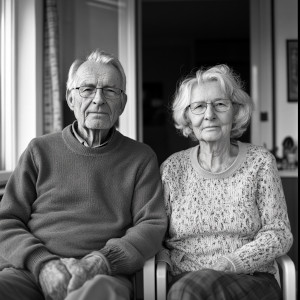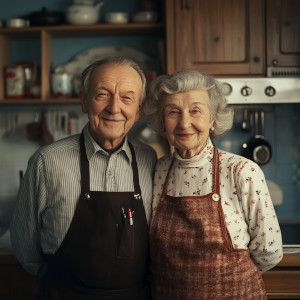
Parchment skin (dry skin), also known as ink skin or diabetic dermopathy, is a term used to describe very thin, almost translucent skin that resembles parchment to the touch. It is a condition that often occurs in older people, especially those suffering from long-term illnesses such as diabetes. Parchment skin can be fragile and easily damaged, increasing the risk of bruising, cracking and other skin problems. In such cases, round-the-clock care for the elderly, including proper skin care, is key to preventing further damage and making life comfortable.
Prevention and treatment
Prevention and treatment of parchment skin in seniors mainly focuses on skin protection and care:
- Moisturizing (making the skin supple, revitalizing the skin): Regular use of emollients and moisturizers can help keep the skin in better condition and prevent excessive dryness.
- Sun protection (hypersensitivity to the sun’s rays): Using sunscreen can reduce further UV damage.
- Adequate diet and hydration (vitamins a and e): A healthy diet rich in antioxidants and adequate hydration help keep skin healthy and promote regeneration.
- Medical consultation (oral retinoids): Regular visits to a dermatologist or general practitioner can help monitor skin conditions and adjust treatment if necessary.
What are the main causes of parchment skin in the elderly?
Parchment skin in the elderly, characterized by its thinness, translucency and ease of bruising, is the result of many factors. Here are the main causes that contribute to its development:
The skin aging process (skin changes in older people):
- As we age, the skin naturally loses collagen and elastin, proteins responsible for its firmness and elasticity. This leads to thinner, more flabby skin that is more easily damaged.
Long-term sun exposure (skin sensitivity):
- UV radiation contributes to the degradation of collagen and elastin in the skin. Long-term sun exposure over the years leads to photoaging, which manifests as thin, papery skin texture.
Genetic factors (risk of occurrence):
- Some people are genetically predisposed to faster thinning of the skin in old age, which may be due to hereditary aspects of collagen metabolism and other skin components.
Chronic diseases (neurological disorders, skin diseases, malignancies):
- Diseases such as diabetes and other chronic conditions can affect the circulation and nutrition of the skin, leading to thinning skin and increased susceptibility to injury.
Understanding these causes is key to preventing and managing parchment skin in the elderly. Taking measures such as sun protection, proper skin moisturization, a healthy diet and regular medical consultations can help maintain the health and integrity of the skin in older age.
Proper care of parchment skin in seniors-methods

The care of parchment skin in seniors requires special care and attention to ensure that it is properly protected and reduces the risk of damage. Here are some effective care methods that can help maintain the health and elasticity of senior skin. Professional care for seniors, including the use of appropriate moisturizers and gentle hydration of the skin, is key to preventing further damage and improving seniors’ comfort.
Gentle cleansing methods (skin care for the elderly):
- Avoid strong detergents and use mild, soap-free cleansers that do not strip the skin of its natural oils. Warm (not hot) water is better for delicate skin.
A diet rich in antioxidants (improve skin condition):
- A healthy diet rich in antioxidants, vitamins (A, C, E) and minerals can support skin health from within. Antioxidants help fight free radicals that contribute to skin aging.
Regular dermatological check-ups (skin lifting):
- Regular visits to a dermatologist are important to monitor the condition of the skin, detect problems early and adjust the skin care plan.
Using humidifiers:
- Maintaining adequate humidity levels in the home, especially during the winter months when heating can dry out the air, will help keep skin moisturized.
The importance of adequate moisturization in preventing parchment skin- protecting the skin of the elderly
Adequate skin hydration is a key element in preventing parchment skin, especially in the elderly. Parchment skin is characterized by significant thinning, dryness and a tendency to become easily damaged, which is directly related to insufficient hydration. Here’s why proper moisturization is so important and its importance in maintaining healthy skin:
Protection of the skin barrier (dermatitis) : Moisturization helps maintain the integrity of the skin barrier, which protects the inner layers of the skin from harmful external agents such as bacteria, viruses and pollutants. When the skin is dry, its protective barrier is weakened, increasing the risk of infection and irritation.
Preservation of skin elasticity (cracked skin, cracking of the epidermis): Moisturized skin is more elastic, which reduces the risk of cracks, abrasions and other mechanical damage to the skin. Moisturizers and creams containing ingredients such as glycerin, hyaluronic acid, and ceramides help maintain skin elasticity, which is especially important in older people who naturally lose collagen and elastin in their skin.
Reduce itching and discomfort (itchy skin): Dry skin often leads to itching, which can prompt scratching, which in turn leads to further damage. Moisturizing the skin regularly helps reduce itching, providing comfort and reducing the risk of self-injury.
Improved skin appearance: Moisturized skin looks healthier and younger. Adequate hydration results in smoother skin with a healthy glow, which can improve the overall well-being and self-esteem of the elderly.
Supporting the healing process (skin wound healing): Moisturizing the skin supports the skin’s natural regenerative processes. Healthy, moisturized skin is better able to repair minor injuries, such as abrasions and cracks.
Regular use of these moisturizing practices can significantly help maintain skin health, reducing the risk of developing parchment skin and related skin problems.
Available therapies and supportive measures for the treatment of parchment skin-diagnosis and treatment

The treatment and management of parchment skin, especially in the elderly, requires a comprehensive approach that includes both professional therapies and daily care at home. Here are some effective therapies and supportive measures that can help improve the condition and function of parchment skin:
Light therapy:
- Phototherapy: Using gentle light waves to stimulate collagen production and improve overall skin condition. Phototherapy can help improve elasticity and reduce dry skin.
Advanced cosmetic formulas:
- Retinol products: Retinol (a form of vitamin A) can help regenerate the skin and stimulate collagen production, which can help increase skin density and reduce translucency.Hidration from within:
- Proper hydration: Drinking the right amount of water each day is key to keeping skin hydrated.
Implementing these therapies and measures can significantly improve the lives of people with parchment skin, reducing its dryness, sensitivity and vulnerability, as well as improving its appearance and protective functions.